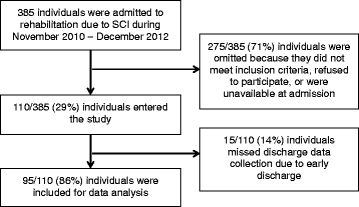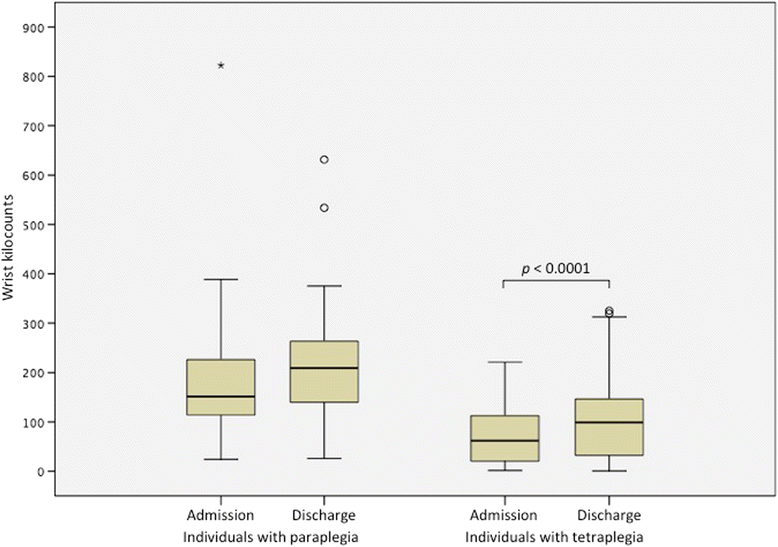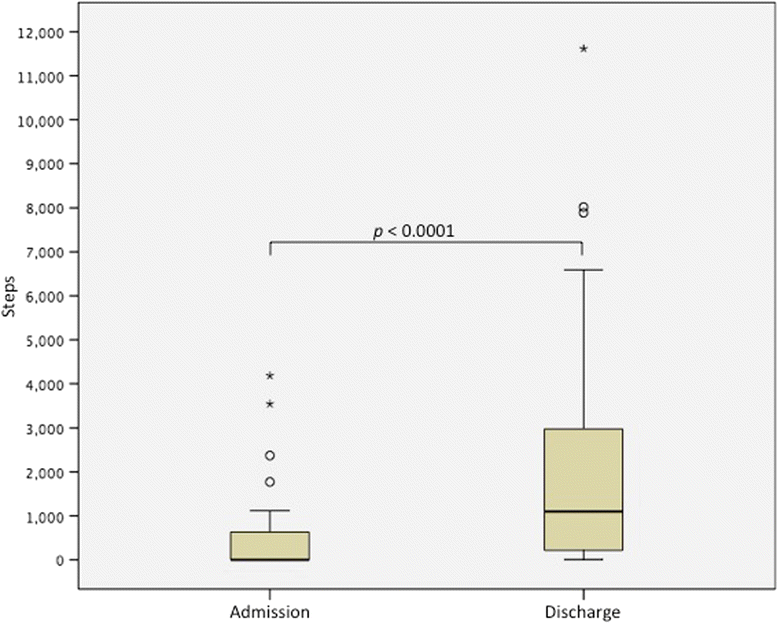Physical activity outside of structured therapy during inpatient spinal cord injury rehabilitation
- PMID: 27846851
- PMCID: PMC5111265
- DOI: 10.1186/s12984-016-0208-8
Physical activity outside of structured therapy during inpatient spinal cord injury rehabilitation
Abstract
Background: Little information exists on the content of inpatient rehabilitation stay when individuals with spinal cord injury (SCI) are not engaged in structured rehabilitation therapy sessions. Investigation of inpatient therapy content is incomplete without the context of activities outside of this time. We sought to quantify physical activity occurring outside of physical therapy (PT) and occupational therapy (OT) sessions during inpatient SCI rehabilitation and examine how this activity changes over time from admission to discharge.
Methods: In this longitudinal observational study at two inpatient SCI rehabilitation centres, 95 participants were recruited through consecutive admissions. Physical activity at admission and discharge was recorded by 1) self-report (PARA-SCI questionnaire) and 2) real-time accelerometers worn on the dominant wrist, and hip if ambulatory. For analyses, we separated participants into those with paraplegia or tetraplegia, and a subgroup of those ambulatory at discharge. Wilcoxon signed rank tests (admission vs. discharge) were used for PARA-SCI minutes and accelerometry activity kilocounts.
Results: There was no change in self-report physical activity, where the majority of time was spent in leisure time sedentary activity (~4 h) and leisure time physical activity at a higher intensity had a median value of 0 min. In contrast, significant increases in physical activity outside PT and OT sessions from admission to discharge were found for wrist accelerometers for individuals with tetraplegia (i.e., upper limb activity) and hip accelerometers for ambulatory individuals (i.e., walking activity).
Conclusion: Physical activity is low in the inpatient SCI rehabilitation setting outside of structured therapy with a substantial amount of time spent in leisure time sedentary activity. Individuals appear to have the capacity to increase their levels of physical activity over the inpatient stay.
Keywords: Accelerometry; Inpatient; PARA-SCI; Physical activity; Rehabilitation; Spinal cord injury.
Figures





Similar articles
-
Cardiovascular Stress During Inpatient Spinal Cord Injury Rehabilitation.Arch Phys Med Rehabil. 2017 Dec;98(12):2449-2456. doi: 10.1016/j.apmr.2017.05.009. Epub 2017 Jun 13. Arch Phys Med Rehabil. 2017. PMID: 28623144 Free PMC article.
-
Movement repetitions in physical and occupational therapy during spinal cord injury rehabilitation.Spinal Cord. 2017 Feb;55(2):172-179. doi: 10.1038/sc.2016.129. Epub 2016 Oct 18. Spinal Cord. 2017. PMID: 27752057 Free PMC article.
-
Physical Activity and Sedentary Behavior From Discharge to 1 Year After Inpatient Rehabilitation in Ambulatory People With Spinal Cord Injury: A Longitudinal Cohort Study.Arch Phys Med Rehabil. 2020 Dec;101(12):2061-2070. doi: 10.1016/j.apmr.2020.06.027. Epub 2020 Aug 1. Arch Phys Med Rehabil. 2020. PMID: 32750374
-
Exercise recommendations for individuals with spinal cord injury.Sports Med. 2004;34(11):727-51. doi: 10.2165/00007256-200434110-00003. Sports Med. 2004. PMID: 15456347 Review.
-
Physical activity promotion to persons with spinal cord injury by health and exercise professionals: A scoping review.J Spinal Cord Med. 2023 Jan;46(1):126-145. doi: 10.1080/10790268.2021.1977061. Epub 2021 Nov 8. J Spinal Cord Med. 2023. PMID: 34747675 Free PMC article.
Cited by
-
Central Recruitment: A process for engaging and recruiting individuals with spinal cord injury/disease in research at Toronto Rehabilitation Institute.J Spinal Cord Med. 2021;44(sup1):S240-S249. doi: 10.1080/10790268.2021.1970898. J Spinal Cord Med. 2021. PMID: 34779741 Free PMC article.
-
'Time is of the essence': upper-body aerobic exercise to improve cardiovascular health during inpatient rehabilitation within the first year following spinal cord injury - protocol for a randomised clinical trial.BMJ Open. 2025 Apr 30;15(4):e089868. doi: 10.1136/bmjopen-2024-089868. BMJ Open. 2025. PMID: 40306990 Free PMC article.
-
Using Sensor Technology to Measure Gait Capacity and Gait Performance in Rehabilitation Inpatients with Neurological Disorders.Sensors (Basel). 2022 Nov 1;22(21):8387. doi: 10.3390/s22218387. Sensors (Basel). 2022. PMID: 36366088 Free PMC article.
-
Development of an Activity-Dependent Epidural Stimulation System in Freely Moving Spinal Cord Injured Rats: A Proof of Concept Study.Front Neurosci. 2018 Jul 23;12:472. doi: 10.3389/fnins.2018.00472. eCollection 2018. Front Neurosci. 2018. PMID: 30083089 Free PMC article.
-
LncRNA/miRNA/mRNA ceRNA network analysis in spinal cord injury rat with physical exercise therapy.PeerJ. 2022 Jul 29;10:e13783. doi: 10.7717/peerj.13783. eCollection 2022. PeerJ. 2022. PMID: 35923891 Free PMC article.
References
-
- Scivoletto G, Morganti B, Molinari M. Early versus delayed inpatient spinal cord injury rehabilitation: an Italian study. YAPMR. 2005;86(3):512–516. - PubMed
Publication types
MeSH terms
LinkOut - more resources
Full Text Sources
Other Literature Sources
Medical

